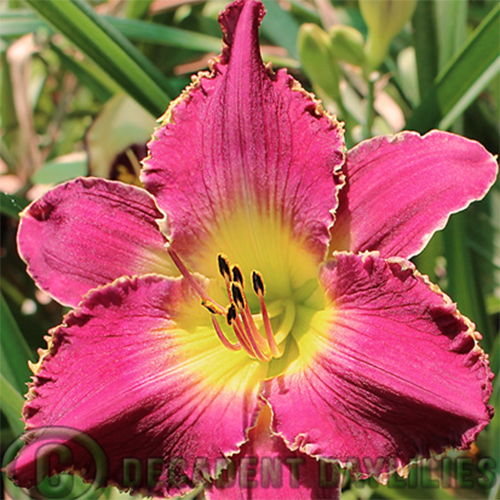Daylilies are an easy to grow rewarding perennial plant that does grow well in all states of Australia.
Daylilies flower prolifically from late spring to early summer and spasmodic flowering in winter. Daylily hybrids have evolved from a small group of species in the genus Hemerocallis.
Until recently, the daylily flower was only available in yellow, orange and fulvous red. Today, however, the colour range varies from white, bright pink, orange, yellow, vivid red, maroon, lavender, purple to nearly true blue and other exotic blends, thanks to the availability of hybridising techniques.
A single daylily flower stays open for one day but daylilies can have up to 50 flowers on one flowering scape. If you select daylilies with different bloom times, this will give you a continuous long flowering display of 6 to 8 weeks during our peak bloom period. Bloom season is from November to January in Australia.
Daylilies have foliage which is either one of evergreen, semi-evergreen or winter dormant. The flowers and flowering of each cultivar can alter depending on the weather, some flower early in a season others flower towards the end of season.
Daylilies have thick to thin lanced shaped light to dark green foliage coming from the crown tissue. The slender to strong hollow scapes have leafless stalks leading to the branching where the clusters of buds are found. The flower buds burst into flower in hundreds of various mixed colours. The newest offerings have consistent and stable fancy patterned eyes others have different broken colour patterns, streaks, stippled, spotted and veined some with frilly finely marked edges in supreme colours or bold eyes and feathered edges and throats.
Here in our home gardens quite a few of our newer daylily hybrids produce a definite continuous flush of blooms. Daylilies can rebloom instantly after the first bloom, on the same plant within the bunch of daylilies planted. I have seen up to 3 instant reblooms on the same flowering plant one straight after the other which is rare. In favoured conditions the majority of modern daylily hybrid blooms appearing again in autumn, meaning you will have a lovely display of daylilies over an extended period.
Plant Daylilies – On my website and blog I have many articles relating to good daylily care, how to plant daylilies, how close to plant daylilies, planting daylily roots and many other daylily planting tips based on my own growing experiences.
Read Our Free Tips regarding – Daylily hybridisation methods, different ways to propagate daylilies, how to propagate daylilies by seed, daylily clump division, daylily proliferations and tissue culture propagation. Also explained about is daylily fungus diseases – daylily crown rot and daylily root rot, daylily spring sickness, daylily mustard seed fungus, daylily scape blasting and lastly daylily rust.
The American Hemerocallis Society has stamped the daylily the perfect perennial because daylilies are drought resistant once established, low maintenance plants and produce an incredible variety of colour for a water wise garden.
Daylilies grow and increase rapidly, also showing great tolerance to a wide range of soil types, but a daylily grows and blooms best when exposed to a minimum 6 – 7 hours of sunlight and provided with well drained slightly acidic soil, rich in organic matter, ideal pH is 6.5, composted with well rotted manure and sufficient watering and fertiliser is important to the health of daylily plants.
Daylilies love to be mulched, mulching is good value it builds the soil up and eventually rots into the ground and keeps the weeds at bay. Never ever recycle daylily leaves as mulch they may have a problem disease use pea or lucerne straw instead it is full of nutrients that will improve the quality of your soil.
Daylilies not flowering is proof that daylilies do not grow well in any soil they need to be fed and watered. Daylilies that have stopped flowering can be stressed plants, try loosening the soil around the plant with a garden fork and water well. Received too much nitrogen rich fertilisers will provide the plant with lots of leaves and no flowers. Adequate sunlight is needed otherwise you risk the chance of consistent blooms every year.
Daylilies have long thickened rambling roots and crowns they are not bulbs so don’t plant them too deep this is another reason for non flowering daylilies.
Daylilies are heavy bud builders, this means more buds and more bloom time. They are not usually sold at florists shops as cut flowers. Hybridising daylilies and other flowers is a favourite pass time. It is very exciting unlocking the genetic pool of the next generation of daylilies and an easy thing for all gardeners young and old to take part in.
Daylily hybrids of today come in an amazing range of colours, shapes, heights, sizes and forms i.e. dwarf daylilies, double daylilies, spider daylilies, miniature daylilies, the normal single daylily and unusual formed daylilies.
There are daylily varieties that are suitable for a wide range of landscaping needs, ranging from short to very tall, miniature size to extra large daylilies. Extra large daylilies must measure larger than 7 inches. Daylily blooms can vary amazingly in size from a tiny 1 inch to a massive 16 inch.
Begin the journey and try growing a daylily today.

